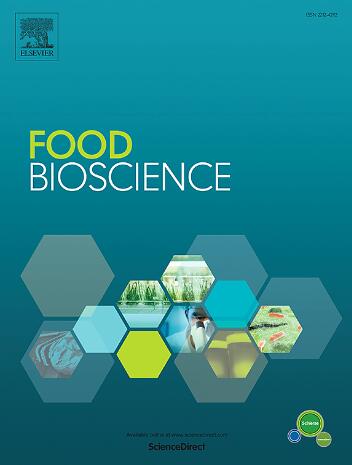靶向金黄色葡萄球菌双组分Agr系统:天然化合物抑制的分子对接和动力学见解
IF 5.9
1区 农林科学
Q1 FOOD SCIENCE & TECHNOLOGY
引用次数: 0
摘要
抗菌素耐药性的不断上升,特别是在耐甲氧西林金黄色葡萄球菌(MRSA)中,需要开发传统抗生素以外的替代治疗策略。靶向群体感应(QS)是一种调节毒力、生物膜发育和毒素分泌的细菌通讯机制,是一种很有前途的抗毒方法。在金黄色葡萄球菌中,由应答调节剂AgrA和传感激酶AgrC组成的辅助基因调节剂(auxiliary gene regulator, Agr)系统在致病性调控中起关键作用。在本研究中,采用基于结构的计算工作流来识别针对AgrA和AgrC的食源性群体感应抑制剂(qsi)。从FooDB数据库中筛选一组生物活性化合物,进行ADMET分析、分子对接、分子动力学(MD)模拟和MM-PBSA结合自由能计算。一些候选化合物表现出很强的结合亲和力(范围在−9至−7.5 kcal/mol之间),并且与AgrA和AgrC的关键残基具有稳定的相互作用。分子力学-泊松-玻尔兹曼表面积(MM-PBSA)分析和相互作用指纹图谱分析表明,这些蛋白-配体复合物具有良好的结合能。总的来说,这些发现表明,食物来源的化合物具有巨大的潜力,可以作为安全有效的qsi,能够破坏金黄色葡萄球菌的毒力途径。这种抗毒策略通过减轻细菌致病性而不施加直接的杀菌压力,提供了一种新的和减轻耐药性的治疗途径。本文章由计算机程序翻译,如有差异,请以英文原文为准。

Targeting the two-component Agr system in Staphylococcus aureus: Molecular docking and dynamics insights into natural compound inhibition
The escalating prevalence of antimicrobial resistance, particularly in methicillin-resistant Staphylococcus aureus (MRSA), necessitates the development of alternative therapeutic strategies beyond traditional antibiotics. Targeting quorum sensing (QS), a bacterial communication mechanism that modulates virulence, biofilm development, and toxin secretion represents a promising anti-virulence approach. In S. aureus, the Accessory gene regulator (Agr) system, comprising the response regulator AgrA and the sensor kinase AgrC, plays a pivotal role in pathogenicity regulation. In this study, a structure-based computational workflow was employed to identify food-derived quorum sensing inhibitors (QSIs) targeting AgrA and AgrC. A curated set of bioactive compounds from the FooDB database was subjected to ADMET profiling, molecular docking, molecular dynamics (MD) simulations, and MM-PBSA binding free energy calculations. Several candidate compounds exhibited strong binding affinities (ranging from −9 to −7.5 kcal/mol) and stable interactions with key residues of AgrA and AgrC. MD simulations over 100 ns confirmed the stability of these protein–ligand complexes, while Molecular Mechanics-Poisson-Boltzmann Surface Area (MM-PBSA) analysis and interaction fingerprint analysis indicated favourable binding energetics. Collectively, these findings suggest that food-derived compounds hold significant potential as safe and effective QSIs capable of disrupting S. aureus virulence pathways. This anti-virulence strategy offers a novel and resistance-mitigating therapeutic avenue by attenuating bacterial pathogenicity without exerting direct bactericidal pressure.
求助全文
通过发布文献求助,成功后即可免费获取论文全文。
去求助
来源期刊

Food Bioscience
Biochemistry, Genetics and Molecular Biology-Biochemistry
CiteScore
6.40
自引率
5.80%
发文量
671
审稿时长
27 days
期刊介绍:
Food Bioscience is a peer-reviewed journal that aims to provide a forum for recent developments in the field of bio-related food research. The journal focuses on both fundamental and applied research worldwide, with special attention to ethnic and cultural aspects of food bioresearch.
 求助内容:
求助内容: 应助结果提醒方式:
应助结果提醒方式:


